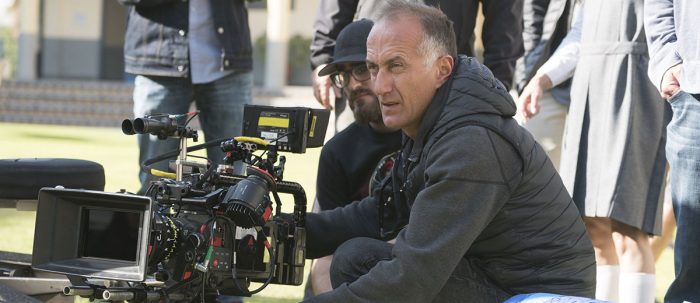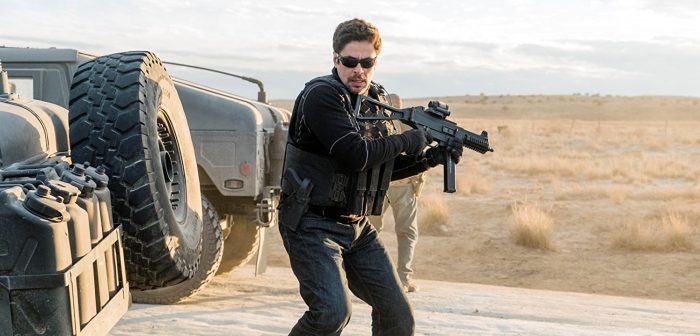
With Sicario: Day of The Soldado, director Stefano Sollima roughened the edges of screenwriter Taylor Sheridan‘s potential trilogy. With Kate Macy (Emily Blunt) no longer around, Sollima felt Alejandro (Benicio Del Toro) and Matt Graver (Josh Brolin) unleashed naturally meant things would turn bleaker. A crowd-pleasing thriller Sollima’s sequel is not, and nor should it be.
It’s a suitably bleak and often unpleasant experience that reveals more about Alejandro and Graver without completely stripping them of mystery. The main thrill is watching one of the best actors around, Benicio Del Toro, continue to make you both fearful and empathetic of Alejandro.
With the sequel now available on Blu-ray, we had the chance to ask Sollima about Del Toro’s performance, his time in El Paso and Juarez, long tracking shots, and more.
When you first got involved, where did your research start? How did you immerse yourself in this world?
I always do in each project that I am involved in. It’s really important to make the movie real, and also it’s really important to get some ideas that are a little bit more original than your own imagination. I think it’s really important opportunity telling the truth and to be realistic, so you as the audience member, what we’re portraying is absolutely the truth.
On Soldado, it was to study how it works, the illegal immigration, by the point-of-view of the Coyotes. So the people who are actually doing it for real, and then what you learn is that they’re a different kind of gangster. Sometimes it’s just logistics, or they just drive people from point A to point B. This is what I studied. Now really, by going to the border by doing interviews, almost everybody could be potentially involved in the product.
What else did you learn from your time in Mexico and El Paso?
I’ve been between the border of El Paso and Juarez, so I’ve been through Juarez. I’ve been back and forth many times to interview people and to understand how they work for real. What’s the process for the Coyote? And on the other side, what we try to learn about a character like Elijah, the kid. His house is the last one before the fence and the border. And so the idea was to, for example, to give them a passport, because with a U.S. passport you can move the border back and forth super quickly. For the cartel, people need to be residents, born and raised in Juarez are more entrusted, and they have more value, because it is easier for them to move back and forth, and to move through the border without being captured or arrested. This is for example an element that we add after the research.
I read you and cinematographer Dariusz [Wolski] watched quite a few documentaries and did a lot of research together. How did that research maybe influence the style and atmosphere you wanted for the film?
I think the visual style, I don’t think it’s something abstract that you decide way before you start prepping the movie. I offer that especially when you shoot a movie like Soldado, that it’s based on quality and shooting almost 95% in real location. It’s like the process is to know what “je ne sais quo” about the movie, and in this case it was to grip you, what’s really important to see and to read, the desert. So for example I decided to go more for long track shots than for multiple cameras set up and that impacts everything. So we went for something that was a little bit more impactful of the mood because it was a little lower, a little bit steadier, and it was more wide. I think that for the night scenes we decided to go for a gritty black mood.

Speaking of those long tracking shots, the caravan sequence is fantastic, just that unnerving music and Benicio Del Toro’s sinister smile. What can you tell me about timing that sequel?
Of course when you work on long track shot, especially if it involves special effects and timing, it’s really important. So, an incredible amount of work, but not in design. Even in a complicated action piece, I want to see the action from the eyes of a character. I did that on the convoy sequence. I decided to go and adopt a specific point-of-view from the little girl, who’s completely freaked out, and scared to death from what she’s experiencing.
Of course you were on location and using practical effects more often than not, but are there any subtle CG effects maybe the eye wouldn’t notice right away?
Yes, of course. It’s happening in the car, you know Benicio Del Toro and the grenade, and in the car we completely added the passenger, Bobby, who is trying to find the bomb right before it explodes. Which wasn’t practical, of course. It was too dangerous, and after everything else is practical.
I find Matt and Alejandro’s relationship fascinating. It was all about the work in the first movie, but I wondered this time how much does Matt actually care for Alejandro, if it all. Does he?
I think that this was something really along with Taylor we worked on a lot, because I think there is a moment that’s real interesting. Because in the beginning, it’s like you portray them as two buddies. They explain to you that they are sort of confidants. They know each other. They worked together a lot, but later on Brian and Matt receive a direct order to kill him. He doesn’t make any objection like, “Oh no. I cannot. He’s my friend.” The only question he asks is, “Do you know how long it takes to make someone like Alejandro?” So, I love this moment because for Matt it’s like comedy in this moment. He’s complaining the time he needed to create this perfect weapon, more than killing the friend. I think it is really interesting the call, when they speak together. I mean, Alejandro probably expected this, but not Matt ordering to kill the girl. So he says get rid of the girl, otherwise I have to come and see you, and the girl. I think it’s an interesting layer in their relationship.
Having played the characters before, I imagine Josh Brolin and Benicio Del Toro had ideas for them for the sequel. What was important to them to communicate in Day of Soldado?
It was an interesting experience because they already knew the character. But the point was that this screenplay that Taylor said it on script was so complex. It was for them, in a way, it was to work by knowing in advance, that is what you learn from the first chapter, but by going really much more deep in the exploration of their character. Because in a way in the first one, the story and Matt and Alejandro are basically seen from Emily Blunt’s character, from her point-of-view. So you know what she sees, and in Soldado you literally experience who they are.
So it’s a much more complex the job. In a way, they know the character. Let’s say you had a sort of grip over what you character could or could not do, but like I said, the job was really complex, so it was a sort of exploration in the deepness of both characters.
My last question for you, I’m curious to see what you’ll bring to the action in the Call of Duty movie after seeing Day of Soldado. What do you have in mind for those set pieces?
It’s a super secret. I cannot say anything about Call of Duty. If so I’d have to kill you [Laughs].
***
Sicario: Day of Soldado is now available on Blu-ray and DVD.
The post ‘Sicario: Day of The Soldado’ Director Stefano Sollima on the Importance of Authenticity and Real Locations [Interview] appeared first on /Film.
from /Film https://ift.tt/2yt8Cr4
